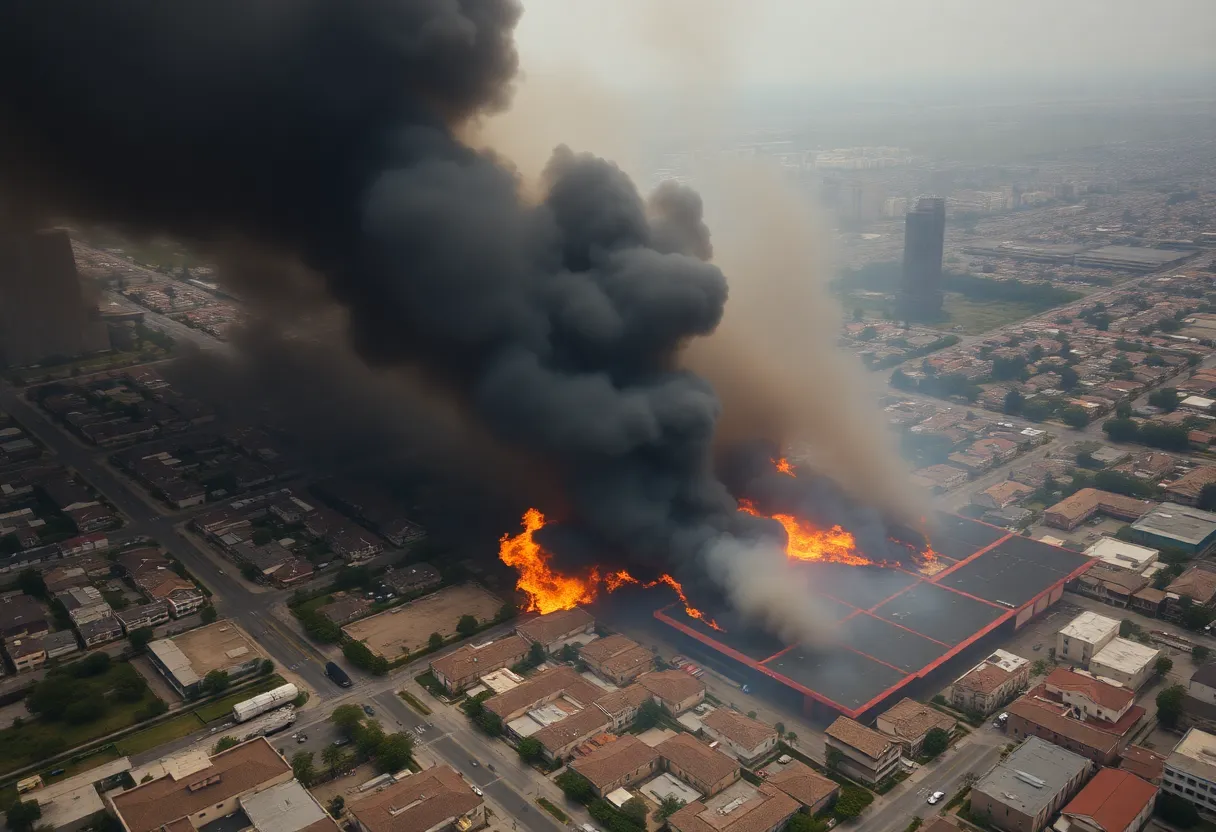News Summary
Major Wildfires Ravaging Los Angeles: A Hidden Asbestos Threat Emerges
As wildfires rage through the Los Angeles area, thousands of residents are under mandatory evacuation orders while others voluntarily flee from their homes and businesses in a desperate attempt to escape the spreading flames. Governor Gavin Newsom has declared a state of emergency as dry winds exacerbate the crisis, allowing the fires to spread rapidly. In this volatile situation, a grave concern has emerged regarding the potential release of legacy asbestos found in older structures.
Uncontrolled Wildfires Create Hazardous Conditions
The wildfires have already devastated numerous communities, destroying hundreds of homes and businesses, including the Palisades Charter High School—an institution founded during a time when asbestos use in school buildings was commonplace. Fires burning through such structures can release harmful asbestos fibers into the air, posing serious health risks for residents and emergency responders alike.
Reports have indicated that tremendous wind gusts—reaching speeds of up to 100 miles per hour in some areas—are contributing to the rapid spread of flames. With the chaotic scenario unfolding, meteorologists have expressed concerns over how dry winds can not only escalate the fires but also disperse asbestos particles throughout the region.
The Hidden Dangers of Asbestos Exposure
Health experts are beginning to notice an uptick in patients presenting with breathing problems in local emergency rooms, although the scope of this increase is yet to be fully assessed. With poor air quality stemming from the fires, those suffering from underlying health issues, including malignant mesothelioma and lung cancer, face particular peril.
As reported, structures built before the 1980s, such as Palisades Charter High School, are likely to contain materials laced with asbestos. When these buildings burn, asbestos fibers become airborne, contaminating the soot, ash, and smoke filling the air. To add to the uncertainties, hundreds of other structures in Los Angeles are also under siege by the flames, raising alarms of widespread exposure.
Precautions Amidst Chaos: Evacuations and Protective Measures
The Los Angeles City Council has noted the heartbreaking loss of hundreds of structures as the fires persist, underscoring the urgent need for evacuation and protective measures. Residents are strongly advised to adhere to evacuation orders and take precautions to guard against inhalation of asbestos-laden air during the ongoing crisis.
Those within the fire zones are encouraged to wear N-100 or P-100 respirators to mitigate the risk of inhaling airborne asbestos fibers. However, with the escalating demand for masks and air filters, finding adequate protective equipment has become a challenge in the region.
Future Risks During Cleanup and Recovery
As the fires eventually die down, the repercussions will continue to jeopardize public health during the cleanup phase. Individuals involved in debris cleanup face serious risks of encountering toxic asbestos if proper precautions are not taken. If large quantities of asbestos-containing materials are found, it is highly recommended to hire professional abatement companies to ensure safe removal.
Unlike other materials, asbestos fibers can remain airborne for hours after being disturbed, heightening contamination risks for those nearby. The toll of previous incidents, like the fire at a historic blimp hangar in Tustin, California, illustrates the potential long-ranging impacts of wildfires on public health. Following that fire, which scattered asbestos debris over three miles, extensive cleanup costs exceeding $123 million were incurred by the U.S. Navy.
Learning from Past Fires: The Lessons of Maui
The recent fires on Maui serve as a stark reminder of the potential dangers posed by wildfires. They highlighted the risk of toxic air contamination and left a tragic legacy of over 100 fatalities and public health warnings related to asbestos exposure. Health officials in the wake of that disaster discovered asbestos in the debris and ash, prompting emergency responses and cautionary measures for the community.
As the flames continue to pose threats in Los Angeles, the unique convergence of wildfires and the hidden legacy of asbestos creates a complex and dangerous situation for residents and emergency responders alike. The rapidly changing conditions demand immediate action and vigilance as communities work together to navigate both the immediate danger of the fires and the long-term health risks posed by asbestos exposure.
Deeper Dive: News & Info About This Topic
HERE Resources
2024: A Pivotal Year for Mesothelioma Treatment Advances
FDA Unveils Proposed Rule to Combat Asbestos in Talc Products
Alarming Rise of Mesothelioma Cases in Louisiana: Navy Veterans at High Risk
Risks of Asbestos Exposure: Protecting Yourself
New Strategic Partnership to Enhance Oncology Treatments
Landmark Case Awards $2.6 Million to Asbestos Victim’s Widow
The Hidden Threat: Mesothelioma and Asbestos Exposure in Florida
Former Marine Mechanics and Maritime Workers Urged to Seek Legal Help for Mesothelioma or Lung Cancer
Mesothelioma Rates On the Rise: A National Health Crisis
Veteran’s Legal Battle for Justice Against Asbestos Exposure
Additional Resources
- Asbestos.com: Raging California Wildfires May Spread Toxic Asbestos
- Wikipedia: Asbestos
- AP News: Military Blimp Fire Hangar Navy Asbestos California
- Google Search: Asbestos California wildfires
- OC Register: Tustin Public Schools to Close Due to Smoke
- Google Scholar: Asbestos exposure wildfires
- KTLA: Asbestos Poor Air Following Historic Hangar Fire
- Encyclopedia Britannica: Asbestos



















